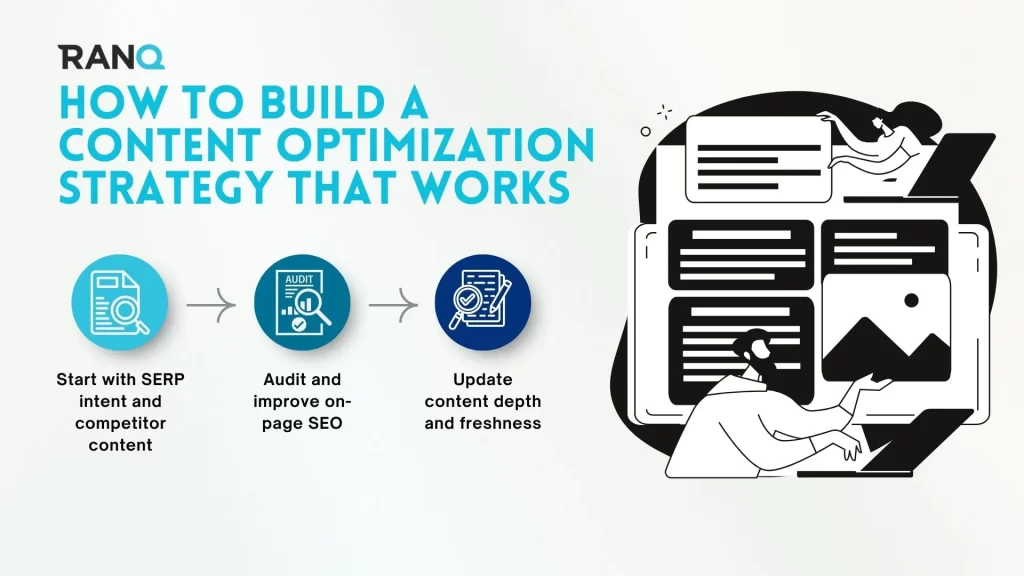It’s not enough to consistently offer quality content to stand out in today’s online market. You also need an excellent content optimization strategy that brings organic traffic to your website. But what is content optimization, and how can you take advantage of it? In this guide, we’ll break down actionable steps that you can implement to optimize your website content for long-term SEO success and better user outcomes.
What Is Content Optimization and Why Does It Matter?

Did you know that 75% of users never even see the second page of Google’s search results? Online visibility is paramount to customer engagement, and content optimization is the best way to increase the frequency and meaningfulness of those interactions.

Content optimization is a strategic process through which you can improve your website’s performance in search engine results pages (SERPs) and amplify your user engagement. If done correctly, it’s also one of the key ways to overtake your competitors and capture a larger potential audience.
Content optimization: What it is (and what it isn’t)
Content optimization refers to continuously improving on-page website content to align with user intent, search engine optimization (SEO) best practices, and your business’s personal goals.
By doing so, you’ll not only increase your engagement and number of leads, but you can also more firmly position yourself as an authority in your industry. You may have heard terminology like “keyword stuffing” or have experimented with A/B testing, but that doesn’t cover the full scope of content optimization.
Optimization is about catering your website’s content to the entire sales funnel and the needs of your customers. It can take many forms, ranging from adjusting on-site formatting and adding external links to expanding previous information and updating irrelevant data.
Why optimized content outperforms even ‘great’ content
What’s crucial for understanding SEO and content optimization practices is that even the highest quality content can become outdated or misaligned with the current search engine results pages’ (SERPs) intent.
When you add SEO tactics to your copywriting and content design, you’ll be able to improve metrics for essential engagement factors like your website’s click-through rate (CTR), time on page, conversion rate, and bounce rate. All of these will feed into your ultimate visibility. Let’s break down each of these metrics and why they matter:
- Click-through Rate: The percentage of individuals who view a website and then click on an ad that appears on that page. A measure of the efficacy of advertising.
- Time On Page: The amount of time a visitor spends reading content on a single page. Measure the efficacy of your website.
- Conversion Rate: The percentage of people who completed an action on your website, like filling out a form or buying a product.
- Bounce Rate: The percentage of users who leave without taking any action. Lowering the bounce rate can lead to increased conversions.
Where most websites go wrong
Every business has different priorities, but there are common issues that most websites face when it comes to content optimization. These include:
- No updates after publishing: SEO practices and content optimization are ongoing processes that require maintenance.
- No internal linking: Don’t just rely on other sites as your sources. Other sites add legitimacy and provide backlinks (links from other sites back to yours).
- No Call to Actions (CTAs): Sometimes, providing great content is not enough. Be direct with your customers by using concise, to-the-point CTAs that clearly convey your audience’s next steps.
- Optimizing for volume instead of intent: Frequency of searches for subject matter is essential, but are they relevant to your audience and your own content?
- Lack of formatting for skimmability (headings, bullets, media): Blocks of text can be helpful for complex subjects, but they’re not as readable. Diversify within individual content with headings, bullets, and media to break up text.
Do you need guidance with avoiding these optimization pitfalls? The SEO experts at Ranq can help.
How to Build a Content Optimization Strategy That Works

In the next section, we’ll walk through how to build a content optimization strategy that you can implement for your own website.
Start with SERP intent and competitor content

Content optimization begins with a deep understanding of what people are already searching for and how your competitors are covering those subjects. Here are some steps for personal research:
- Begin with keyword research using tools such as Ubersuggest, Google Suggest, or Semrush. Try to come up with a list of about 10 keywords that are relevant to your business. The rule of thumb is usually that the longer the keywords, the less competitive they are.
- After picking keywords, look at the top 3-5 SERP results and note patterns in content and subject matter (e.g., list posts, FAQs)
- Semrush can also help with tasks like competitor analysis, showing you shared keywords on those websites.
- Look at what Google is ranking highly and reverse-engineer the structure and intent for your own content.
- Tools like Ahrefs, Clearscope, or manual searches can all help you evaluate your headings, tone, and the media you could use to boost engagement.
Audit and improve on-page SEO
After crafting your content, you’ll want to create a checklist for how you can audit and improve your website’s on-page SEO. Tools like Screaming Frog can help tell you what’s missing. Here are some things to include on your checklist:
- Meta title/headers: Website page’s primary topic and purpose. Clear, concise, descriptive.
- Keyword density: Don’t force keywords, make it organic. Some suggest 1-2 keywords for every 100 words.
- Number of internal/external links: Links to other pages on the same website vs. pages on different websites.
- Image Alt Text: Accessibility feature. Use short but descriptive file names.
- Structured Data (Schema Markup): Helps search engines better understand content and improves visibility.
- Integrating secondary and long-tail keywords: Along with primary keywords, include secondary and long-tail keywords that are more specific. Writing about those niches will increase visibility with those searches.
Update content depth and freshness
Updating your own content is a requirement to keep in line with SERP’s intent. Here are some general guidelines for updating content:
- Add new data, relevant examples, and case studies
- Remove links or sections that have become outdated since publishing.
- Add video, interactive tools, or FAQs that address patterned questions from high-ranking pages.
- Refresh isn’t a rewrite, but a realignment with current expectations and SEO practices.
If you feel like your content is becoming stale, reach out to the experts at Ranq.
Great Content Isn’t Enough; It Has to Be Optimized
Whether you’re able to write great content in your sleep or struggle to write the first paragraph, being able to write isn’t enough in today’s online market. You need optimized content that aligns SEO practices, high-caliber content, and UX modifications to attract new leads and retain customers.
You don’t have to do it alone, though. At Ranq, we specialize in keyword strategy, content optimization, and routine monthly optimization processes that can help you achieve more organic traffic to your website. Contact Ranq for your free content optimization strategy today.



